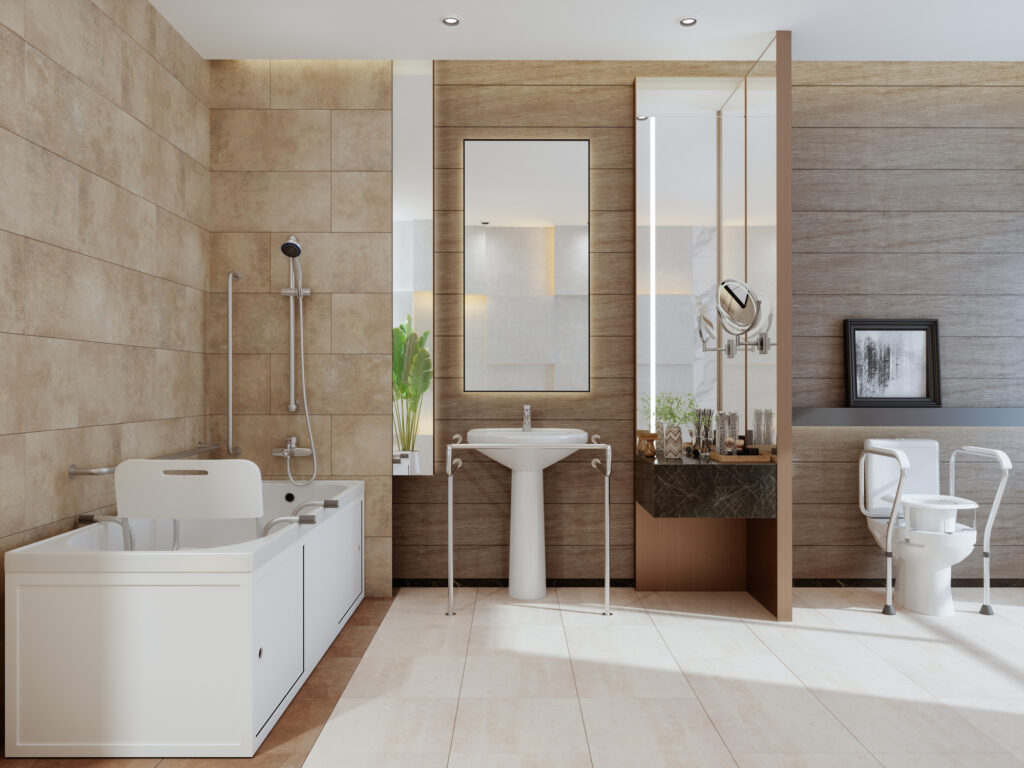As families in Ottawa prepare to support aging loved ones or plan for their later years, ensuring home environments remain safe and functional becomes a top priority. Among the most vital areas requiring thoughtful planning is the bathroom. The phrase “bathroom for seniors Ottawa” underscores an essential shift toward creating accessible, dignified, and future-ready spaces.

Rather than reacting to mobility limitations once they arise, many Ottawa homeowners and caregivers are choosing to plan. Forward-thinking design ensures safety, comfort, and independence, without sacrificing aesthetics or practicality.
The Importance of Futureproofing Bathrooms
Bathrooms can quickly become hazardous without modifications. Wet floors, slippery tiles, and tight layouts pose serious fall risks, especially for seniors. Transitioning these spaces into safe zones not only prevents accidents but also fosters autonomy.
Futureproofing isn’t just about accommodating mobility devices or age-related changes—it’s about empowering people to live confidently in their own homes. With smart design and the right fixtures, a bathroom can adapt to changing needs over time, making it a wise investment for families and property owners alike.
Planning with Purpose: Assessing Current Needs and Future Possibilities
Every successful bathroom remodel for aging in place begins with a solid plan. Before making any structural changes, it’s essential to assess the current and anticipated needs of the user. Considerations include:
- Existing Mobility: Are there current challenges with balance, walking, or using stairs?
- Progressive Conditions: Are chronic illnesses or degenerative conditions a factor?
- Assistance Requirements: Is help from a caregiver currently needed or expected in the future?
- Layout Limitations: Are doorways too narrow? Is the space cramped or hard to navigate?
A careful evaluation allows for prioritizing improvements that will serve both immediate safety and future adaptability.
Barrier-Free Showers and Walk-In Bathtubs
Traditional bathtubs and shower-tubs are among the most dangerous bathroom fixtures for older adults. Climbing over high thresholds increases the chance of slips and falls. For this reason, walk-in bathtubs and zero-threshold showers have become a cornerstone of age-friendly design.
Walk-In Bathtubs
These come equipped with a door that opens outward or inward, allowing the user to enter without lifting their legs. Many include built-in seats, hydrotherapy features, and easy-to-reach controls.
Roll-In and Curbless Showers
A roll-in shower eliminates the need to step over any ledge. The seamless entry allows wheelchair access or easier use of a walker. Additions like fold-down benches, handheld showerheads, and anti-slip flooring make the experience safer and more convenient.
Safe Flooring: Slip-Resistant and Comfortable
A safe bathroom starts from the ground up. Tile, while beautiful, is often slick when wet. Opting for non-slip flooring materials is a fundamental change that drastically improves safety.
Top Flooring Options
- Textured Vinyl: Soft underfoot and water-resistant.
- Rubber Flooring: Durable, slip-resistant, and cushioning—ideal for those with joint pain.
- Textured Porcelain Tiles: When paired with non-slip finishes, they offer beauty and practicality.
Adding underfloor heating is also beneficial, keeping surfaces warm and reducing the risk of condensation.
Grab Bars and Handrails: Functional and Discreet
Gone are the days when grab bars looked clinical. Modern options blend seamlessly with décor while offering crucial support where it’s needed most.
Strategic Placement
- Beside the toilet for assistance with sitting and standing.
- In the shower or tub area, to prevent falls.
- Near the sink to stabilize while bending over.
To make the space future-ready, install blocking (extra wood reinforcements) behind walls during a remodel. This allows for future bar installation even if they aren’t needed right away.
Height-Appropriate Fixtures: Sinks, Toilets, and Cabinets
Comfort-Height Toilets
Standard toilets may be too low for older adults with joint issues. Comfort-height models sit two to three inches higher, making sitting and standing more manageable.
Wall-Mounted and Pedestal Sinks
These open up floor space for walkers or wheelchairs, and make it easier to maneuver close to the basin.
Accessible Storage
Drawers with pull-out shelves and D-shaped handles are easier to grip. Avoid overhead cabinets and opt for storage within easy reach to prevent stretching or climbing.
Lighting That Prioritizes Clarity and Safety
As eyesight diminishes with age, bathroom lighting plays a vital role. Harsh shadows or dim areas can make navigation difficult.
Recommendations
- Layered Lighting: Combine ambient, task, and accent lights for full coverage.
- Motion Sensors: Automatically light the path when someone enters—helpful during nighttime visits.
- Anti-Glare Fixtures: Reduce eye strain and ensure visibility even during early mornings or evenings.
Backlit mirrors and toe-kick lighting under cabinets add both elegance and functionality.
Lever Handles and Touch-Free Controls
Traditional twist knobs and small buttons are often difficult to operate for seniors with arthritis or reduced grip strength. Lever-style handles are easier to manage and require minimal pressure.
Recommended Upgrades
- Single-lever faucets for easier temperature control.
- Touchless faucets that activate with a wave of the hand.
- Hands-free soap dispensers to minimize bending or reaching.
Toilet flush levers can also be replaced with push-button or sensor-activated versions for added ease.
Widening Doorways and Optimizing Layout
Standard bathroom doorways may not accommodate walkers or wheelchairs. Future-ready design should aim for at least 34–36 inches of clearance.
Open, unobstructed layouts are ideal. Key changes to consider:
- Relocating the toilet or vanity for a better turning radius.
- Replacing swinging doors with pocket or barn doors to save space.
- Removing underused elements (like large soaking tubs) to create additional floor space.
Emergency Alert Features
Bathrooms are one of the most common areas for household accidents. Having an emergency alert system in place provides peace of mind for both users and their families.
Simple Additions
- Waterproof call buttons are placed at accessible heights.
- Pull cords near the toilet and inside the shower.
- Voice-activated smart assistants are programmed to call for help when prompted.
These systems allow a user to summon assistance even if mobility is impaired during a fall.
Ventilation and Air Quality
Humidity control is often overlooked, yet crucial for aging occupants who may have respiratory sensitivities.
Recommendations
- Quiet exhaust fans with humidity sensors help prevent mold.
- Windows with easy-slide mechanisms offer fresh air without physical strain.
- Air purifiers or bathroom plants (like aloe vera or bamboo palm) can naturally improve air quality.
Proper ventilation also prevents moisture accumulation that could make floors slippery.
Designing for Caregivers
Some seniors may eventually need support from caregivers. A futureproof bathroom should be as functional for an assistant as it is for the individual.
Features to Aid Caregivers:
- Open shower spaces to accommodate two people.
- Movable commode chairs or patient lifts for bathing.
- Wide entryways and turning space for caregivers using mobility aids.
Designing with care assistance in mind ensures that if the need arises, the space won’t require another overhaul.
Blending Safety with Style
Futureproofing doesn’t have to mean sterile or institutional. With thoughtful product choices and cohesive design, safety features can blend seamlessly into a modern, stylish space.
Aesthetic Choices
- Brushed nickel grab bars that match towel racks.
- Custom tiling in roll-in showers for visual warmth.
- Floating vanities paired with soft-close drawers for a sleek look.
Functionality and beauty can coexist, making it easier to embrace upgrades now that enhance value and livability for years to come.
Budgeting and Planning for Long-Term Value
While modifying a bathroom involves upfront investment, it’s far more cost-effective than relocating or retrofitting an inaccessible space later.
Key cost-saving tips:
- Focus on structural upgrades first (layout, door width, plumbing).
- Install rough-ins for future upgrades (like grab bar blocking or electrical for bidets).
- Choose modular features that can adapt or be replaced individually.
Prioritizing critical safety features, then building outward from there, ensures the remodel serves both current comfort and future flexibility.
Why Choose Adaptive Living?
Adaptive Living is dedicated to helping Ottawa homeowners build environments that grow with them. Our work is rooted in listening, planning, and executing solutions that make everyday life more comfortable and secure.
What sets us apart is the ability to translate real-life mobility challenges into seamless, stylish design. We never use one-size-fits-all approaches—instead, every bathroom we remodel is tailored to the lifestyle, preferences, and needs of the individual.
We understand how deeply personal these changes can feel. That’s why our team takes the time to walk through every decision, ensuring you feel confident and empowered as your home evolves with you.
Adaptive Living is your partner in building a bathroom that isn’t just safe for tomorrow, but comfortable, beautiful, and supportive for many years to come.



